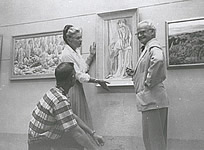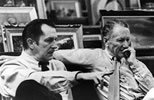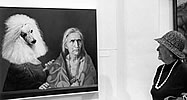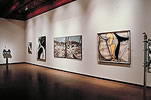exhibition dates
history
jurors
acknowledgments
about the museum
credits
"THE JURY WILL CAUSE ALL THESE TO—STOP!"
THE ORIGINS OF THE JURIED EXHIBITION
Although modern-day New Mexico is known for its numerous venues for exhibiting art, the art-colony towns of Taos and Santa Fe had no such spaces in the 1910s. By 1915 artists from the region were exhibiting their work at the historic Palace of the Governors, which housed the Museum of New Mexico. But the demands of a burgeoning art community soon required more, and an Art Gallery, today known as the Museum of Fine Arts, opened its doors in November of 1917.
 During its first two decades, the Museum of Fine Arts had an open-door policy regarding exhibitions. New York artist Robert Henri had visited Santa Fe and advised Museum of New Mexico Director Edgar L. Hewett that this would be the best means of showcasing art being created in New Mexico. The result was the first contemporary art museum in the United States and a wonderfully egalitarian exhibition space.
During its first two decades, the Museum of Fine Arts had an open-door policy regarding exhibitions. New York artist Robert Henri had visited Santa Fe and advised Museum of New Mexico Director Edgar L. Hewett that this would be the best means of showcasing art being created in New Mexico. The result was the first contemporary art museum in the United States and a wonderfully egalitarian exhibition space.
Legend has it that exhibitions evolved from a pad of paper placed in the museum lobby, to which any artist could add his or her name. In time, as one’s name reached the top of the list, the artist was given an alcove in which to create, exhibit or sell art works. Hewett reflected on the open door policy in 1937:
Its alcoves have been open to the most eminent painter or sculptor, to the unknown beginner . . . all on equal terms. There has been no jury, no favoritism for any theory, or 'school' of art. . . . We believe firmly in the integration of the arts, of all the agencies that bring beauty and harmony into the lives of men.
Each year since the Art Museum was built in Santa Fe, an annual show, intended to include every artist in the region has been held in September. This year, marking the twentieth anniversary of the event, a special effort was made to make the exhibition truly representative of the work being done, and the result was eminently successful so far as New Mexico and its immediate environs are concerned. More than a hundred artists, dominated by the Santa Fe and Taos groups as usual, but including a surprising number from other towns of the State were represented, and a notable show was produced. (El Palacio, Volume 43, nos. 10-12, p.55, September 8-15-22, 1937).
The "open door" exhibition policy attracted artists from all over the state, and a few artists of national repute. John Sloan summered in Santa Fe and championed the non-juried approach to art exhibitions.
 He had organized a number of open-door exhibitions in New York. This policy worked well, as long as the community of artists remained small. By the 1940s, however, there were too many artists vying for exhibition space, and the museum had amassed a sizeable permanent collection that also needed to be exhibited. The community began to debate the merits of shifting to an annual juried exhibition. In El Palacio’s June 1947 edition, Hester Jones is quoted as saying, "John Sloan has said that all art is good as long as there is someone who likes it. The non-jury policy is still being put to the test. We believe it has been and is the best policy here."
He had organized a number of open-door exhibitions in New York. This policy worked well, as long as the community of artists remained small. By the 1940s, however, there were too many artists vying for exhibition space, and the museum had amassed a sizeable permanent collection that also needed to be exhibited. The community began to debate the merits of shifting to an annual juried exhibition. In El Palacio’s June 1947 edition, Hester Jones is quoted as saying, "John Sloan has said that all art is good as long as there is someone who likes it. The non-jury policy is still being put to the test. We believe it has been and is the best policy here."
Despite protestations, the Museum of Fine Arts abandoned the open-door policy in favor of juried exhibitions in 1951. When artist John Sloan, who summered in Santa Fe, received the news that the museum had decided to hold its first juried exhibition, he objected vigorously. He was in New Hampshire, dying, but in control of his faculties enough to fire off the following telegram to his friend, fellow Santa Fe artist, Will Shuster:
I have just heard that S.F. Art Museum is having its first Juried Ex. — STOP! This means there will be no more distinction about the Annual Ex. STOP. The famous Open Door Annual of Santa Fe will be no more. STOP. Robert Henri and Edgar Hewett will 'turn in their graves' muttering — STOP. … The 'Open Door' might have let in Publicity, Honesty, Equity. The jury will cause all these to — STOP.
Some argued that the museum lost a little of its "small town feel" when it abandoned the open-door exhibition policy,
 but the community was growing. The economic boom of post-war America brought even more artists to New Mexico, and enabled them to cobble out a living amidst its vibrant light and landscape.
but the community was growing. The economic boom of post-war America brought even more artists to New Mexico, and enabled them to cobble out a living amidst its vibrant light and landscape.
The juried exhibition format allowed more artists to exhibit at the museum, with works selected from a jury that often consisted of artists, connoisseurs, critics or curators. Will Shuster, a member of the Cinco Pintores and creator of Zozobra, joined Taos painter Barbara Latham on a jury in 1957, and Hondo Valley tempera master Peter Hurd seemed to enjoy being on a jury with actor and art collector Vincent Price in 1964.
After more than fifty years, the juried exhibition continues to be one of the formats by which the Museum of Fine Arts showcases contemporary art of the region. Relative to today’s invitational or juried biennials, a juried exhibition is a more egalitarian method: Every three years,
 the Museum of Fine Arts solicits work by any artist working in any medium, with the only restriction being a residency requirement. The selection of works is made by a jury of three through a blind process that requires the jurors to choose according to the merits of the individual artworks without any knowledge of who created them. Lastly, perhaps the best measure of the juried exhibition’s egalitarianism is the opportunity it provides for emerging artists, some exhibiting for the first time in a museum setting, to show alongside more established artists.
the Museum of Fine Arts solicits work by any artist working in any medium, with the only restriction being a residency requirement. The selection of works is made by a jury of three through a blind process that requires the jurors to choose according to the merits of the individual artworks without any knowledge of who created them. Lastly, perhaps the best measure of the juried exhibition’s egalitarianism is the opportunity it provides for emerging artists, some exhibiting for the first time in a museum setting, to show alongside more established artists.
Ellen Zieselman, Curator of Education